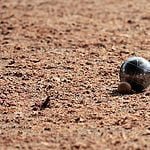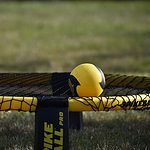You might have wondered about the Double Bounce Rule in pickleball and how it impacts gameplay. Understanding this rule is crucial for players looking to enhance their skills and strategy on the court.
So, what exactly does this rule entail, and why is it considered a fundamental aspect of pickleball? Let's explore the intricacies of the Double Bounce Rule and its significance in shaping the dynamics of this increasingly popular sport.
Key Takeaways
- Promotes fair competition and skill development.
- Enhances gameplay by encouraging longer rallies.
- Levels the playing field and fosters strategic play.
- Revolutionizes doubles dynamics with tactical shot-making.
Double Bounce Rule Basics
Why is the Double Bounce Rule essential to understand in the game of pickleball?
The Double Bounce Rule is a fundamental aspect of pickleball rules that dictates the ball must bounce once on each side of the court during the first two shots of a rally. This means that both the serve and return must bounce before players can engage in volleys or groundstrokes. By implementing this rule, the creators, Joe Pritchard and Bill Bell, aimed to prevent immediate net crashing, introduce strategic gameplay elements, extend points, and ensure a fair and entertaining experience for all players.
Understanding the Double Bounce Rule is crucial as it not only adds depth to the game but also promotes longer rallies, eliminates the serve and volley advantage, and enhances the overall gameplay experience. This rule forces players to engage in more prolonged exchanges, showcasing their skills and strategy while maintaining a balanced playing field. Mastering the Double Bounce Rule is key to excelling in pickleball and enjoying its competitive yet engaging nature.
Importance of Double Bounce Rule
Understanding the significance of the Double Bounce Rule in pickleball enhances gameplay strategy and promotes fair competition among players. This rule plays a crucial role in maintaining fair competition by ensuring that both teams have an equal opportunity to return the ball before engaging in aggressive play. By requiring the ball to bounce once on each side of the court during the first two shots, the rule extends rally duration, adding strategic depth to the game. It prevents immediate net crashing, giving players more time to strategize their shots and making matches more engaging.
The Double Bounce Rule evens the playing field by eliminating serve and volley advantages, requiring players to rely on skill and tactics rather than quick, aggressive tactics. In official tournament rules, this rule is included to enhance the overall pickleball experience, encouraging longer rallies and fostering a more competitive environment that rewards skill and strategy over brute force.
Impact on Gameplay
The Double Bounce Rule in pickleball significantly influences gameplay dynamics by encouraging longer rallies, strategic maneuvers, and a level playing field for all players.
This rule mandates that the ball must bounce once on each side of the court, affecting the flow of the game from the very start. By requiring both the serve and return to bounce, players are compelled to engage in more extended rallies, fostering a strategic approach to each shot.
The impact of this rule is profound, as it not only prolongs the exchanges but also promotes fair competition by limiting immediate aggressive tactics like net crashing. This adds depth and complexity to the gameplay, challenging players to think tactically and execute well-planned shots.
Origin of Double Bounce Rule
Introduced in 1965 by Joe Pritchard and Bill Bell, the Double Bounce Rule in pickleball aimed to level the playing field for all participants, particularly beginners, by requiring the ball to bounce once on each side of the court in the first two shots. Joe Pritchard, a U.S. Congressman, and Bill Bell, a successful businessman, collaborated to create this rule that revolutionized the game of pickleball. The origin of the double-bounce rule can be traced back to their desire to enhance the sport's accessibility and fairness to players of all skill levels.
- Collaboration: Joe Pritchard and Bill Bell worked together to establish the rule.
- Innovation: The double-bounce rule introduced a unique element to pickleball gameplay.
- Fairness: The rule aimed to create a more equitable environment, especially for beginners.
- Skill Development: Requiring the ball to bounce twice encourages players to develop their shot-making abilities.
- Historical Significance: The partnership between Pritchard and Bell marked a pivotal moment in the evolution of pickleball.
Purpose of the Rule
After grasping the origin of the Double Bounce Rule in pickleball and its collaborative creation by Joe Pritchard and Bill Bell in 1965, delving into the purpose of this rule sheds light on its significant impact on gameplay dynamics and player engagement.
The Double Bounce Rule serves a crucial role in promoting fair play by preventing immediate net crashing after the serve. By requiring the ball to bounce once on each side of the court, this rule extends rallies and ensures that players have equal opportunities to return shots, ultimately adding depth to the game.
Implementing the Double Bounce Rule eliminates the serve and volley advantage, encouraging longer and more strategic gameplay. While beginners may initially find the rule confusing, it plays a vital role in enhancing the overall pickleball experience by fostering skill development and fostering a competitive environment.
Embracing this rule not only maintains the integrity of the game but also elevates the level of play and engagement among players.
Official Rule Book Explanation
Explaining the rationale behind the Double Bounce Rule in pickleball adds clarity to its essential role in shaping gameplay dynamics and player engagement. The official rule book provides a comprehensive explanation of this rule, underscoring its significance in maintaining fairness and enhancing the overall pickleball experience. Here's a breakdown to help you understand the rule better:
- Serve: The Double Bounce Rule applies to the serve, necessitating that the ball bounces once on the server's side and once on the receiver's side before any volleys can be attempted.
- Volley: This rule impacts the volley phase of the game, ensuring that players engage in rallies from the very beginning, promoting skillful shots and strategic gameplay.
- Rule Enforcement: The Double Bounce Rule was crafted to prevent players from exploiting immediate net crashing tactics, fostering a more balanced and competitive environment.
- Fair Play: By requiring two bounces before volleys, this rule promotes fair play, giving both teams an equal opportunity to showcase their skills and tactics.
- Game Dynamics: Implementing this rule adds depth and complexity to the game, encouraging players to strategize and engage in more extended rallies, thereby enhancing the overall pickleball experience.
Application in Serving and Returning
To fully grasp the impact of the Double Bounce Rule in pickleball, understanding its application in serving and returning is essential for players seeking to elevate their gameplay strategy.
The rule, as outlined in the official rule book, mandates that both the serve and return must bounce once before players can engage in volleys.
This requirement not only promotes longer rallies but also prevents immediate net crashing, balancing the game and creating a fair playing field for all participants.
Example in Doubles Play
In doubles play, the application of the double bounce rule ensures a strategic and fair exchange between teams by requiring the ball to bounce once on each side of the court after the serve. This rule adds depth to the game and encourages skillful shot selection.
Here is an example to illustrate how the double bounce rule functions in doubles play:
- After the serve, the ball must first bounce on the serving team's side.
- The receiving team then hits the ball back after it bounces on their side, making their groundstroke.
- The serving team can now make their groundstroke, initiating the third shot of the point.
- The receiving team can choose to volley the ball or hit it off the bounce on the fourth shot.
Adhering to the double bounce rule in doubles play promotes longer rallies, fair gameplay, and the development of strategic shot-making skills.
Exceptions and Special Cases
After understanding the application of the double bounce rule in doubles play, exploring exceptions and special cases further enhances the depth of strategic considerations in pickleball. In wheelchair pickleball, players are granted the allowance of a double bounce on each side to accommodate their unique playing style and movement capabilities. Unlike traditional play, the second bounce for wheelchair players can land anywhere on the playing surface, extending even to the surrounding areas around the court. This adaptation ensures inclusivity and fairness, enabling players with mobility challenges to actively participate and enjoy competitive play. By incorporating the double bounce rule for wheelchair pickleball, the sport showcases its adaptability to different player needs and emphasizes the importance of creating a welcoming environment for all participants.
| Exception | Description | Importance |
|---|---|---|
| Wheelchair Pickleball | Allows for a double bounce on each side to support players' playing style and movement in wheelchair pickleball | High |
| Playing Style Adaptations | Accommodates unique playing styles and movement capabilities, enhancing inclusivity in the sport | Medium |
| Accessibility and Fair Play | Ensures fairness and equal opportunities for all players, promoting a level playing field in competition | High |
Tips for Mastering the Rule
When aiming to master the Double Bounce Rule in pickleball, focus on positioning yourself strategically to anticipate the ball's trajectory effectively. Here are some tips to help you improve your game:
- Stay Balanced: Maintain a stable stance to react quickly to shots from your opponents.
- Watch Your Opponent: Pay close attention to your opponent's movements to predict where the ball may go next.
- Practice Footwork: Work on your footwork to ensure you're in the right position to reach the ball before it bounces twice.
- Hit with Control: Focus on placing your shots accurately rather than just hitting the ball hard.
- Communicate with Your Partner: If you're playing doubles, communication is key to coordinating your movements and covering the court effectively.





